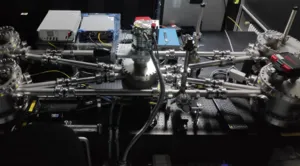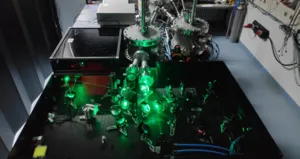Green enhancement cavity for high-energy coherent X-ray generation

Since its commissioning in October 2015, the Munich Compact Light Source (MuCLS) as an X-Ray source based on inverse Compton scattering has been responsible for a vast amount of scientific papers.
Inverse Compton scattering means that an electron storage ring provides the necessary electrons, which are scattered on infrared photons from an overlapping, counter-propagating enhancement cavity. Dividing the wavelength of the enhancement cavity in half will double the energy of the X-ray photons and will expand the application range of this coherent X-ray source significantly.
Therefore, members of E11 currently develop a cavity with the necessary enhancement factor. For this purpose, a 100 W frequency-doubled Yb:YAG delivers laser pulses with a duration of 10 ps and a frequency of 64,8 MHz. The convergence and wavefront of the laser pulse are adapted and sent to an extensive vacuum system, where four mirrors in the so-called bow-tie configuration form the enhancement cavity. When the desired performance of the resonator is secured, it will be integrated into the Compact Light Source at the Munich Institute of Biomedical Engineering (Prof. Pfeiffer).
While the sample thickness – especially regarding samples with a high bone-/mineral contingent – is currently limited to a few centimeters, the upgrade will provide the means to examine samples with higher absorption, even an entire human knee.
Furthermore, the upgrade will expand the scope of applications significantly, mainly due to the possibility of more extensive samples – an application with considerable interest for geological samples (e.g., Oil in porous rock) and historical specimens (fossils, historical artifacts) as well as material scientific samples that could be scanned in operation.

